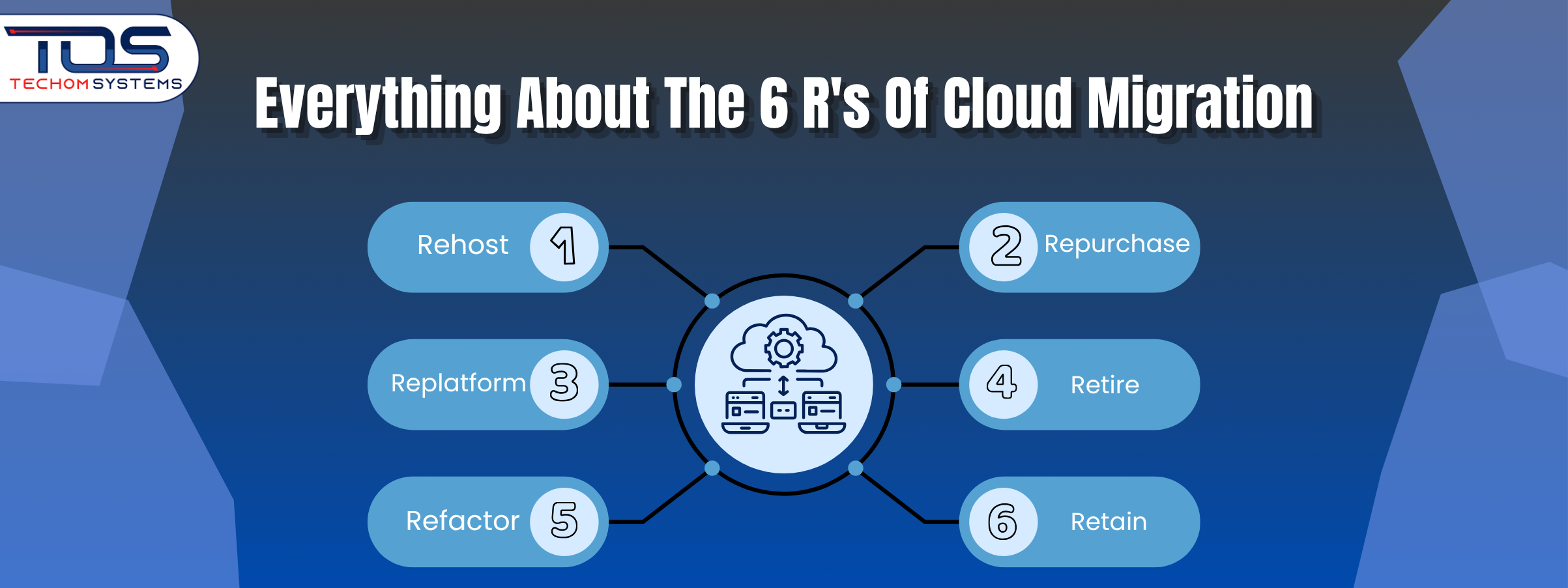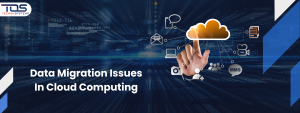Are you unsure which cloud migration approach is right for your business applications? Making the wrong choice can lead to delays, high costs and performance issues. Many businesses face this challenge when planning the migration of applications to cloud platforms.
Moving to the cloud is no longer optional for companies that want to grow and stay secure. It helps you scale faster, reduce overhead and focus on what matters most. But without a clear strategy, cloud migration can feel confusing and risky.
The 6 R’s of cloud migration offer a simple and proven way to make smarter decisions. These strategies help you select the best path based on your business needs, existing systems and future goals. Whether you are using cloud migration services for the first time or refining your process, understanding these 6 R’s will make your journey easier and more successful.
Need expert help with your cloud migration strategy? Contact TECHOM Systems today to speak with our consulting team.
What Are The 6 R’s Of Cloud Migration?
The 6 R’s of cloud migration are six practical strategies that help businesses move their applications to the cloud in a smarter and more efficient way. Every organization has a unique setup and not all applications can be moved the same way. Selecting the right strategy ensures your cloud migration is aligned with both technical requirements and business goals.
By using the 6 R’s of cloud migration, you can reduce risks, control costs and improve performance during the migration process. These strategies are widely used by both small businesses and large enterprises to make cloud adoption more successful and stress free.
To make your move successful, it is important to understand the 6 strategies for migrating applications to the cloud. These strategies, also known as the 6 R’s, provide a flexible and structured approach that aligns with different business goals, technical environments and budgets.
A Closer Look At Each Of The 6 R’s

When businesses plan cloud migration, one size fits all does not work. Each system has its own role, complexity and value. The 6 R’s framework gives a flexible way to make smart decisions based on both technical needs and business priorities. Choosing the right path can lead to faster transformation, cost savings and better performance. Let’s break down each R with insights to help you choose the best option:
#1: Rehost
Rehosting is the simplest way to begin cloud migration. You take your existing applications and move them to cloud servers without changing the code. It is also known as lift and shift.
Use Rehost if:
- You need to migrate quickly to avoid hardware or data center costs
- Your application is stable but not cloud optimized
- You want to test the cloud environment with minimal investment
Why it works:
It reduces downtime, keeps the original setup intact and helps businesses start their cloud journey without a long planning cycle.
#2: Replatform
Replatforming allows you to improve your application slightly during migration. For example, changing the underlying database, introducing auto scaling or upgrading to managed services.
Use Replatform if:
- You want better performance without a full rebuild
- Your team can make small technical changes
- The goal is to optimize speed and cost without delay
Why it works:
It introduces better efficiency and flexibility while avoiding the risk of rewriting complex systems. You get more out of the cloud with limited effort.
#3: Refactor
Refactoring means redesigning your application to use cloud native services such as microservices, containers or serverless functions. It is a deep transformation with long term benefits.
Use Refactor if:
- You want your app to scale with demand automatically
- You need continuous delivery and faster release cycles
- Your app must support future innovations and integrations
Why it works:
Though resource heavy, this method gives you full control, scalability and adaptability for the future. It’s ideal for companies with a strong digital product roadmap.
#4: Repurchase
Sometimes, rebuilding or modifying an app is not worth it. Repurchasing replaces older tools with modern SaaS platforms like Google Workspace, Salesforce or Office 365.
Use Repurchase if:
- The existing tool is outdated or too expensive to maintain
- A cloud SaaS solution already exists with better features
- Your team wants ready to use tools with less management
Why it works:
It saves time, reduces IT support burden and lets employees use tools that are always updated, secure and easy to access.
#5: Retire
During assessment, you may discover apps or systems that no longer serve any purpose. These can be shut down to clean up the environment.
Use Retire if:
- An application has zero business value
- It creates unnecessary licensing or security overhead
- You are simplifying your digital ecosystem
Why it works:
Retiring legacy systems lowers costs, reduces system noise and sharpens your cloud focus. It also improves security and performance across your environment.
#6: Retain
Not everything needs to move right away. Retaining means keeping some systems on premise due to compliance, latency or internal dependency reasons.
Use Retain if:
- Your data must stay on premise for legal or contract reasons
- The app is too tightly linked to legacy hardware or tools
- You plan to migrate it later, after critical systems are moved
Why it works:
Retaining avoids rushed decisions. It ensures stability and gives teams time to plan and prepare a proper cloud migration roadmap for complex systems.
These six strategies provide a clear path for the migration of application to cloud, making the process easier and more efficient for growing businesses.
Not sure which R is right for your business? Contact TECHOM Systems today for a personalized consultation. Our experts will guide you toward the most efficient and cost effective migration strategy.
Which Cloud Migration Path Should You Take?
Once you understand the 6 R’s of cloud migration, the next step is choosing the path that best supports your business goals. Every organization is unique. Some may prioritize speed and cost efficiency, while others may look for long term scalability or easier maintenance. The table below gives a quick side by side comparison to help you find the right migration path for your applications:
| Migration Strategy | Best Fit For | Key Benefit | Quick Tip |
|---|---|---|---|
| Rehost | Businesses wanting to move quickly without changing code | Saves time and cost by lifting and shifting applications to the cloud | Great for legacy systems that just need to run on cloud infrastructure |
| Replatform | Teams looking for better performance without rewriting the entire app | Minor improvements to take advantage of cloud features like scalability and performance | Use when you want a balance between speed and modernization |
| Refactor | Businesses expecting rapid growth and higher demands | Full cloud native benefits including flexibility, reliability and performance | Choose this when building for the future with high traffic in mind |
| Repurchase | Organizations switching to modern SaaS tools | Eliminates the need to maintain older systems | Ideal when managing current tools becomes too expensive or outdated |
| Retire | Apps that are no longer used or needed | Reduces costs and simplifies your IT environment | Audit your systems regularly to spot what can be shut down |
| Retain | Apps that must stay on premise due to compliance or technical limits | Avoids risk and supports systems that are not ready to migrate | Keep this option when you are not ready or migration is unnecessary |
Choosing the right cloud migration strategy helps you avoid unnecessary risks and sets the foundation for long term success. Whether you need a quick shift or a complete rebuild, each path has its purpose. Review your business goals, application needs and budget carefully before making a decision.
Why Do Businesses Use The 6 R’s Framework?

When it comes to moving applications to the cloud, businesses often feel overwhelmed by the number of choices. Without a clear plan, cloud migration can lead to confusion, delays and unnecessary expenses. The 6 R’s framework helps simplify that process.
The 6 R’s of cloud migration offer a simple way to break down complex decisions into manageable strategies. Instead of treating every application the same, businesses can analyze their systems and choose the best path for each one. The framework supports flexibility, helping organizations move at their own pace. Here are the top reasons businesses use the 6 R’s of cloud migration:
- Clear direction for each application
Not all apps serve the same purpose. Some are critical to daily operations, while others are outdated. The 6 R’s framework lets you evaluate each app separately and choose what to rehost, refactor or retire. - Support for different timelines
Some businesses need cloud migration services for businesses that allow them to act quickly, especially when rehosting core apps. Others can plan longer term improvements by choosing to refactor or replatform based on future goals. - Better alignment with business needs
Cloud strategies must match both technical and business goals. The 6 R’s help decision makers understand how each migration method impacts cost, performance and long term growth. - Reduced risk and higher confidence
Having a structured approach lowers the chances of failed migrations or unexpected downtime. It also gives teams more confidence in their migration journey. - Optimized resource utilization
Each migration path under the 6 R’s helps you allocate time, budget and technical resources more effectively. By avoiding a one size fits all model, businesses can prevent resource waste and focus efforts where they matter most.
The 6 R’s framework not only simplifies planning but also improves the success rate of cloud migration efforts. With the right strategy in place, businesses can move forward with confidence and clarity.
Choose TECHOM Systems For Cloud Migration Services
Looking for a cloud migration partner that truly understands your needs? TECHOM Systems offers dependable cloud migration services designed to simplify your journey to the cloud. We combine strategy, support and seamless migration to ensure your business moves forward without disruption. At TECHOM Systems, our trusted cloud migration consulting services ensure that your migration strategy is secure, scalable and aligned with your long term business vision. Here is how we help your business succeed with cloud migration:
- Strategic Guidance
We start by understanding your goals. Our experts create a tailored cloud roadmap that matches your business priorities and helps you stay competitive in a digital first world. - Seamless Migration
We handle the transition with precision. Your move to the cloud is managed by specialists, ensuring your systems remain available and your data fully secure throughout the process. - Trusted Support Throughout
From planning to post migration, we are with you at every step. Our cloud migration services provide ongoing support so you can focus on running your business without worry. - Cost Optimization
We make your cloud budget work smarter. By using a pay as you go model, we help you reduce waste and allocate resources more efficiently, improving overall IT cost control. - Security and Compliance
Keeping your data safe is our top priority. We build cloud environments with secure cloud migration strategies that meet industry standards and compliance requirements, so your business runs confidently and securely. - Business Transformation
Moving to the cloud is only the beginning. Our cloud migration services in Australia help drive innovation, boost operational performance and create better experiences for your customers.
Ready to make your move to the cloud simple and secure? Contact TECHOM Systems today and speak to our cloud experts. We are here to guide you every step of the way.
Frequently Asked Questions About The 6 R’s Of Cloud Migration
#1 What Are The 6 Pillars Of Cloud Computing?
The six pillars are security, scalability, reliability, cost efficiency, manageability and performance. These foundational elements support a stable and future ready cloud environment for businesses of all sizes.
#2 What Are The 7 R’s Of Cloud Migration?
The 7 Rs are Rehost, Replatform, Refactor, Repurchase, Retire, Retain and Relocate. Each strategy helps businesses plan their cloud migration based on current workloads and future needs.
#3 What Are The 5 R’s Of Cloud Migration?
The 5 R’s of cloud migration include Rehost, Refactor, Revise, Rebuild and Replace. TECHOM Systems helps apply the right cloud migration strategy to match your business goals and IT environment.
Final Thoughts
Throughout this blog, we explored each of the 6 R’s of cloud migration and how they support different business needs. You have learned how to assess what to rehost, replatform, refactor, repurchase, retire or retain. At TECHOM Systems, we help businesses simplify cloud migration using the right mix of these strategies to ensure long term success and smooth adoption.
Need Help Choosing The Right Cloud Migration Strategy?
Contact TECHOM Systems today and get expert guidance to move your business to the cloud with clarity and confidence.

Technical Specialist with 3+ years of experience in implementing IT infrastructure, AI-driven automation and supporting digital innovation. His work focuses on helping businesses adopt reliable, future ready technologies that improve performance and protect critical data. He brings a practical, solution-focused approach to every IT challenge.






